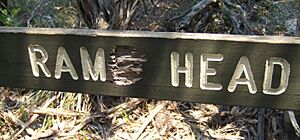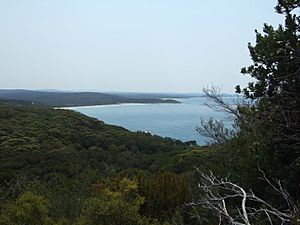Rame Head (Victoria) facts for kids
Ram Head (or Rame Head since 1970) is a piece of land that sticks out into the sea. It is located on the eastern coast of Victoria, Australia. This special place is found inside the beautiful Croajingolong National Park.
The local Aboriginal people have their own names for this headland. They call it Konowee or Kouowee.
History of the Name
This headland was named by Captain Cook. He sailed past it on April 19, 1770. Captain Cook named it "Ram Head". He chose this name because it looked like another place called Rame Head in England. That English headland is near Plymouth Sound.
How the Name Changed
Captain Cook wrote the name as "Ram". Many important mapmakers and explorers used this spelling too. These included Matthew Flinders and others. The British Navy also used "Ram" for the Australian headland.
However, the English headland's name changed back to "Rame" in the early 1800s. This was an older way of spelling it.
In 1971, the Victorian Government decided to change the name of the Australian headland. They changed it to "Rame Head". This was done to match the spelling of its namesake in Cornwall, England.
Why the Name Matters
A famous Australian mapmaker, Geoffrey Ingleton, wrote about this in 1986. He said that Matthew Flinders correctly identified Cook's "Ram Head". Flinders knew it was a conical hill on a distinct piece of land. The current Rame Head perfectly fits this description. This shows that the name and location were correctly identified long ago.
Exploring Rame Head
There is a walking track that leads to the top of Rame Head. However, the very top doesn't have wide-open views. This is because of the surrounding bushes and trees. The highest point is marked by a trig point, which helps in surveying.



